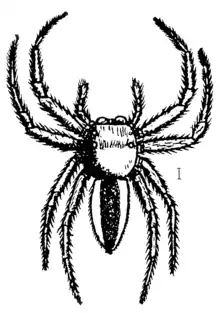| Phintella pygmaea | |
|---|---|
 | |
| The related male Phintella versicolor | |
| Scientific classification | |
| Domain: | Eukaryota |
| Kingdom: | Animalia |
| Phylum: | Arthropoda |
| Subphylum: | Chelicerata |
| Class: | Arachnida |
| Order: | Araneae |
| Infraorder: | Araneomorphae |
| Family: | Salticidae |
| Subfamily: | Salticinae |
| Genus: | Phintella |
| Species: | P. pygmaea |
| Binomial name | |
| Phintella pygmaea Wesołowska, 1981 | |
Phintella pygmaea is an endemic species of jumping spider in the genus Phintella that lives in China. It was first described in 1981 by Wanda Wesołowska from a holotype discovered in Guangdong. Only the female has been identified. The spider is small, with a brown cephalothorax and yellow abdomen. It has distinctive half-crescent markings on the cephalothorax and a ridge marked by two depressions on the small epigyne.
Taxonomy
Euophrys pygmaea is a species of jumping spider that was first described in 1981 by Wanda Wesołowska.[1] It was one of over 500 species identified by the Polish arahcnologist during her career.[2] The species name is derived from the Latin word for dwarf. The genus, Euophrys was first described by Carl Ludwig Koch in 1834.[3] The name derives from two Greek words, meaning good and eyelids.[4]
In 2000, the species was moved to the genus Phintella by Dmitri V. Logunov and Yu M. Marusik based the appearance of the female holotype.[5] This genus had been raised in 1906 by Embrik Strand and W. Bösenberg. The genus name derives from the genus Phintia, which it resembles.[6] The genus Phintia was itself renamed Phintodes, which was subsequently absorbed into Tylogonus.[7] There are similarities between spiders within genus Phintella and those in Chira, Chrysilla, Euophrys, Icius, Jotus and Telamonia.[8] Genetic analysis confirms that it is related to the genera Helvetia and Menemerus and is classified in the tribe Chrysillini.[9][10] There is some uncertainty about the exact taxonomy of the species as only one example has been identified.[11]
Description
Only the female has yet been identified.[1] The spider was initially described based on a holotype specimen found in 1965. The spider is small, with a brown oval cephalothorax that measures 1.69 mm (0.067 in) in length. It has two distinctive lighter markings behind the eye field that are shaped like half crescents.[12] The eye field itself is black. The abdomen is pale yellow, although slight traces of brown belts may be seen, and is 1.75 mm (0.069 in) long. The spider has a very small epigyne which has a ridge lined by two depressions.[13][14]
Distribution
Phintella pygmaea was first found in the Guangdong in China.[12] The species is endemic to the country.[1]
References
Citations
- 1 2 3 World Spider Catalog (2017). "Phintella pygmaea (Wesolowska, 1981)". World Spider Catalog. 18.0. Bern: Natural History Museum. Retrieved 23 April 2017.
- ↑ Wiśniewski 2020, p. 6.
- ↑ Zha, Jin & Zhang 2014, p. 368.
- ↑ Fernández-Rubio 2013, p. 127.
- ↑ Logunov & Marusik 2000, p. 268.
- ↑ Bösenberg & Strand 1906, p. 333.
- ↑ Cameron & Wijesinghe 1993, p. 16.
- ↑ Prószyński 1983, p. 43.
- ↑ Maddison & Hedin 2003, p. 541.
- ↑ Maddison 2015, p. 231.
- ↑ Logunov & Marusik 2000, p. 269.
- 1 2 Wesołowska 1981, p. 49.
- ↑ Wesołowska 1981, p. 50.
- ↑ Peng 2020, p. 306.
Bibliography
- Bösenberg, W.; Strand, Embrik (1906). "Japanische Spinnen" [Japanese Spiders]. Abhandlungen der Senckenbergischen Naturforschenden Gesellschaft. 30: 93–422.
- Cameron, H. D.; Wijesinghe, D. P. (1993). "Simon's Keys to the Salticid Groups". Peckhamia. 3 (1): 1–26.
- Fernández-Rubio, Fidel (2013). "La etimología de los nombres de las arañas (Araneae)" [The etymology of the names of spiders (Araneae)]. Revista ibérica de Aracnología (in Spanish) (22): 125–130. ISSN 1576-9518.
- Logunov, Dmitri V.; Marusik, Yu M. (2000). "Miscellaneous notes on Palaearctic Salticidae (Arachnidaa: Aranei)". Arthropoda Selecta. 8 (4): 263–292.
- Maddison, Wayne P.; Hedin, Marshal C. (2003). "Jumping spider phylogeny (Araneae: Salticidae)". Invertebrate Systematics. 17 (4): 529–549.
- Maddison, Wayne P. (2015). "A phylogenetic classification of jumping spiders (Araneae: Salticidae)". The Journal of Arachnology. 43 (3): 231–292. doi:10.1636/arac-43-03-231-292. S2CID 85680279.
- Peng, Xianjin (2020). 中固功物志: 元香椎劫物第五十三卷: 蛛形鋼 蜘蛛目 跳蛛科 [Fauna Sinica, Invertebrata 53, Arachnida: Araneae: Salticidae] (in Chinese). Beijing: Science Press. ISBN 978-7-03063-853-3.
- Prószyński, Jerzy (1983). "Position of genus Phintella (Araneae: Salticidae)". Acta Arachnologica. 31 (2): 43–48.
- Wesołowska, W. (1981). "Salticidae (Aranei) from North Korea, China and Mongolia". Annales Zoologici, Warszawa. 36: 45–83.
- Wiśniewski, Konrad (2020). "Over 40 years with jumping spiders: on the 70th birthday of Wanda Wesołowska". Zootaxa. 4899 (1): 5–14. doi:10.11646/zootaxa.4899.1.3.
- Zha, Shanjie; Jin, Chi; Zhang, Feng (2014). "The first description of the male Euophrys atrata and E. bulbus from southern China (Araneae: Salticidae)". Zootaxa. 3779 (3): 368–374.